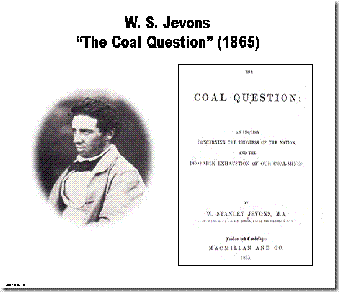Industrial Wind Power: An Old, Tried Failure (the intermittency curse then and now)
By Robert Bradley Jr. -- December 29, 2009Best of MasterResource: 2009
This post orginally appeared (with comments)
on March 4th
The disadvantage of windpower as a primary energy source has been long recognized. This 1838 textbook described the competitive situation of wind as follows:
William Stanley Jevons also detailed the problems of windpower in his 1865 classic, The Coal Question,
in his 1865 classic, The Coal Question,
which was the subject of a previous MasterResource post.
An issue of the Scientific American in 1891 profiled the following experimental wind turbine generating electricity in the northeastern U.S .:
So beware of the hyperbole about windpower being the next great thing. It is a very old thing that could not, and still cannot, compete with the manifold advantages of hydrocarbon energies.



Today I drove past Altamont Pass again, and once again observed that none of the thousands of wind turbines was turning. Which was odd, since I was driving through a rainstorm which should have been powering the wind turbines at near their maximum. However, I was able to observe the Altamont Pass wind farm almost daily for nine years from the five-acre ranch we lived on south of the pass. Most of the time it seemed more inactive than otherwise, causing me to wonder how anyone could consider wind power a viable and reliable (not to mention economical) source of electrical energy.
Only a fool, and a self-deluded one at that, could believe in it.
Good information Richard.
It is always useful to have historical material such as you post above handy and I thank you.
Excellent.
For an in-depth exposé and devastating critique of the futility of industrial wind “power”, see the recently-published book, “The Wind Power Scam” by British ecologist Dr John Etherington. (And perhaps buy a couple of kerosene lamps while you’re at it.)
Ryelands: Glenn Schleede recommended this book at MasterResource here:
http://www.masterresource.org/2009/12/the-wind-farm-scam-by-john-etherington/
My grandad drilled water wells and installed windmills. The farmers always went electric when the cost of running wire was low. For wind, the generators whine and ask the government to pay for the gathering grid. It can cost more than the generators.
The transmission system loses 15% of the electricity for every 50-60 miles of transmission line.
Without tax payer funding, we would not have wind powered electric.
The real problem with wind is its relentless random variability. If the technology was simply unpredictictably intermittent yet generated at a steady rate, it might do some good. As it is, however, it makes conventional generators work much harder to compensate for the continuous now you see it, now you don’t flux–with major thermal implications and greatly increased costs.
Very interesting Jon. I learned something new (which means that something old has to drop out with my nearly full ‘memory card’)